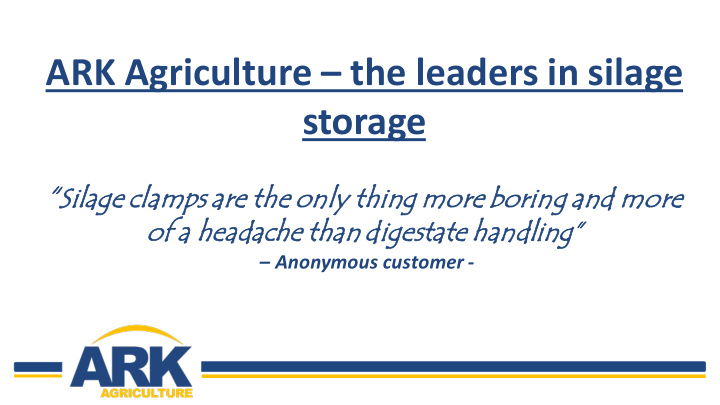



ARK Agriculture – the leaders in silage storage “ Silag age e clamps ps are the only thing more e boring and more e of a headache than digestate handling” – Anonymous customer -
Background Silage Storage Regulations Clamp design Covering and managing The future Questions
• Patented sloping walled silage clamps, oxygen barrier silage sheets and clamp accessories • 70 clamps in the UK • 1.7m tonnes of silage in ARK clamps
Losses
What was your silage feedstock bill for 2018? What would 20% of this be? *Total bill = ££££ / 5* Keep this number in mind throughout the presentation
Silage storage Options
Chose your system
Design your clamps • Capacity (tonnes) • Material (maize grass, WC) • Feed- out rate (m’s per week) • Footprint (where on the site?) • Machinery (weight) • Covering (sheet sizes) • The EA (SSAFO) • Planning permission (yes or no?) • Site falls 2 (with or against the clamps) • Existing drainage (is there any) • The Wind (across the clamps
Fill your clamps Filling the silage clamp is the most important job on your plant And for most plants it is a team effort between you and your contactor Golden rules • 1 minute per tonne per tractor • 1/3-1/4 of the weight entering the clamp per hour in machinery • 15cm layers (or less) • Never re-roll • The clamp filling dictates the speed not the harvester
Cover your clamps ARK clamp Gravel bags netting OXYSEAL oxygen Sidewall barrier silage sheet sheet Silage ARK panel Back fill
Empty your clamps Emptying your clamps is a daily process that is often done by a lone worker. Removing the covers and emptying a silage clamp and is arguably the most dangerous action on an AD plant Golden rules • The silage face must be kept sharp straight and clean • Operators should never walk closer than 4m to the silage face on top or below • Taking the covers off should never be done alone • Clamps should never be allowed to overhang • Once removed from the clamps silage should be fed immediately
Identifying bad silage Measuring wastage in the clamps will guide you on future planning and help identify failures in the silage making process - Identify who’s direct responsibility it is to manage and measure your silage quality + have a schedule and reporting structure - Identify a third party with the right scientific knowledge and equipment to review your clamps regularly - Measure , measure, measure - everything in and out of clamps - Use your gut instinct – good silage doesn’t smell, isn't wet, isn't hot, isn't dark in colour ‘if it looks like a duck and quacks like a duck’
Causes of losses (again!)
Things I would like to talk about with more time * but you are glad I wont!* • Operator Safety on silage clamps • The future of silage clamp covering and silage clamp design • What to do with old silage clamps that are failing • What to do with new silage clamps that are failing • What is the difference in the designs of silage clamps • Why are we only just getting to grips with silage clamp waste
Come and see ARK on stand number H109 • Email sales@arkagriculture.com • Call 01787220560
Recommend
More recommend